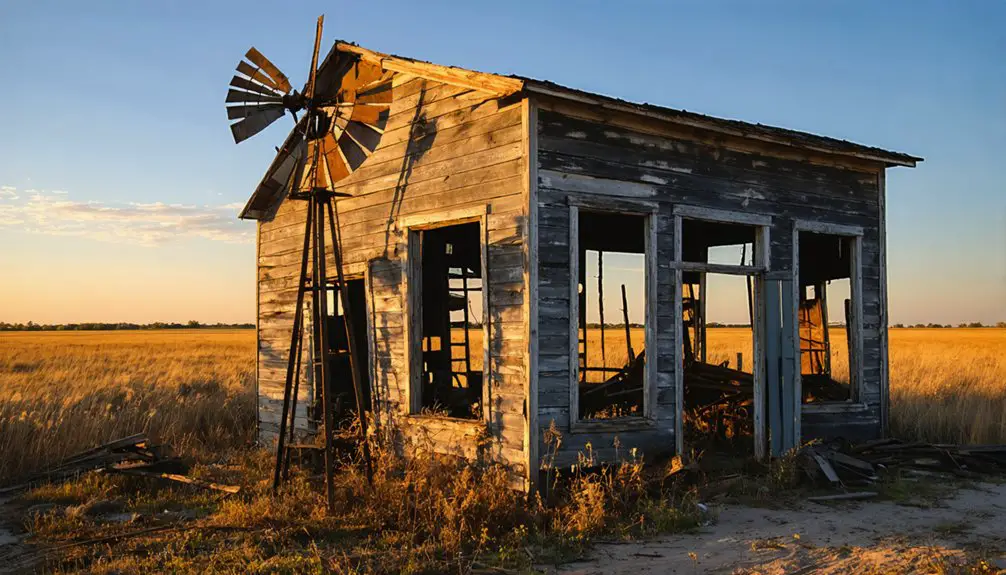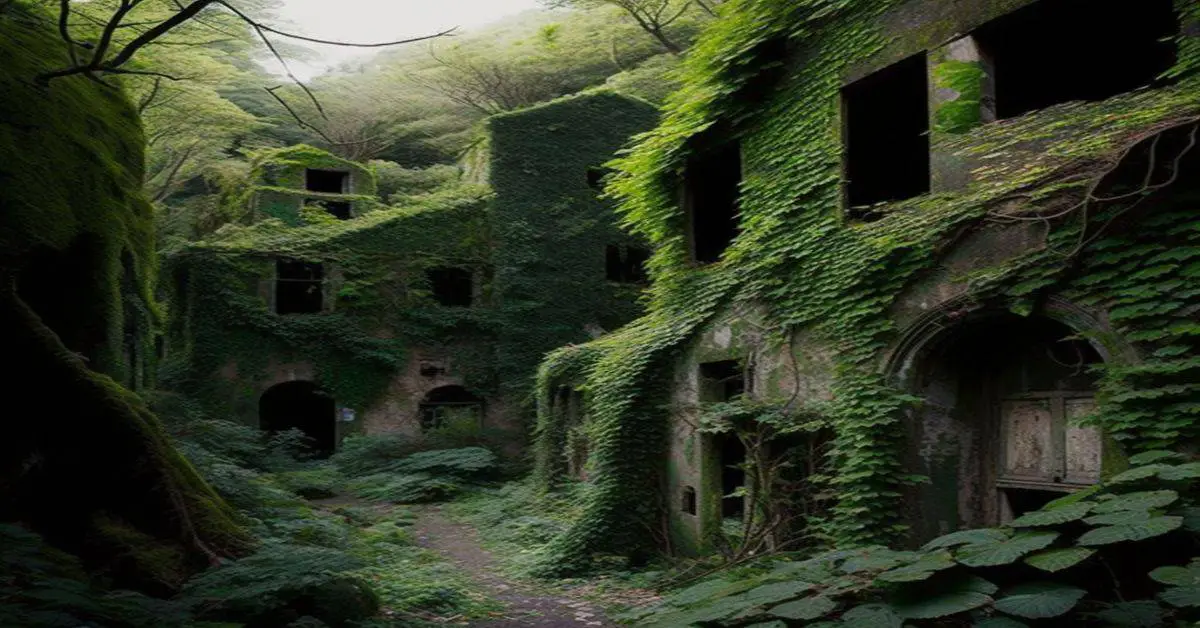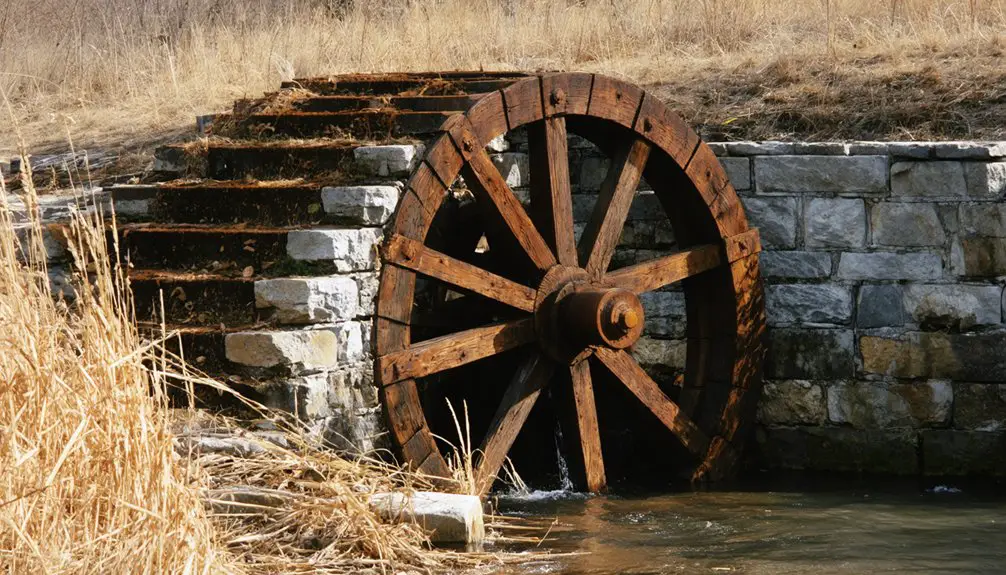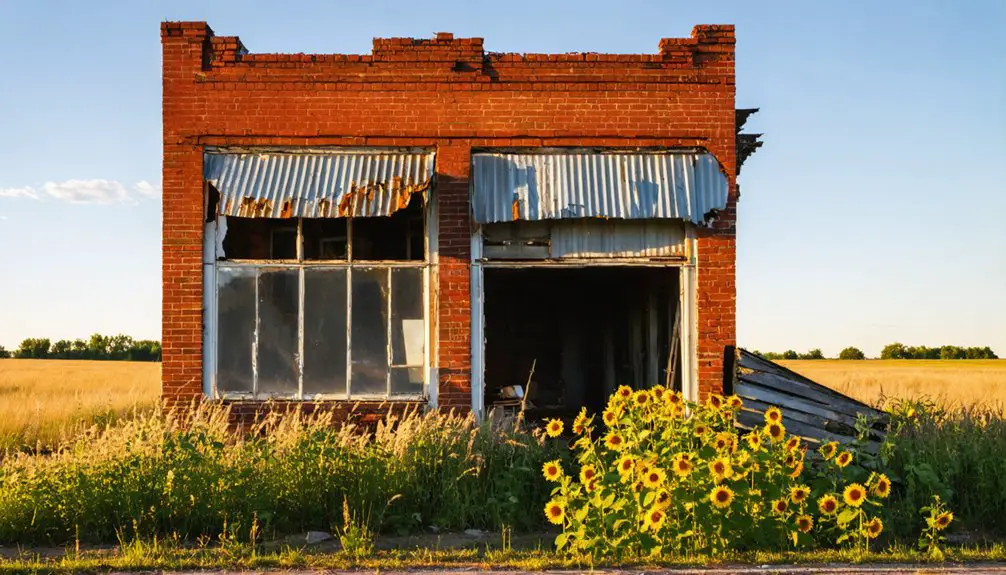You’ll find Mildred along the old Missouri, Kansas & Texas Railway, where a once-bustling cement town sprang to life in 1907. Named after company president J.W. Wagner’s daughter, this industrial powerhouse employed 375 workers and boasted two hotels, retail stores, and a movie theater. The Great Depression forced the cement company’s closure, transforming a vibrant community of 2,000 into a quiet hamlet of just 25 souls. The weathered buildings and local stories paint a fascinating picture of boom-to-bust Americana.
Key Takeaways
- Mildred, Kansas, established in 1907, transformed from a thriving cement town of 2,000 residents to just 25 people today.
- The Great Western Portland Cement Company’s closure during the Great Depression triggered the town’s dramatic decline.
- Abandoned buildings and reduced railroad service mark Mildred’s transition from industrial center to ghost town status.
- Historical landmarks like Charlie Brown’s Market and the Mildred Store remain as testaments to the town’s commercial peak.
- Local preservationists maintain the town’s heritage through storytelling and archives of the former cement company town.
The Birth of a Company Town
When industrialist Sam T. Dermott established the Great Western Portland Cement Company in 1907, you could feel the buzz of opportunity in the air. He’d purchased 260 acres west of the Missouri, Kansas & Texas Railway, laying the company foundations for what would become a thriving Kansas community.
The economic structures took shape quickly – a massive $2,000,000 cement plant rose from the prairie, accompanied by a carefully planned 40-acre townsite for the workers. Within the first year, the plant employed three hundred workers who helped transform the operation into a bustling industrial center.
The M-K-T Railway depot provided vital transportation links for the growing operation. You’d have seen the rapid transformation as Coal Creek was dammed to supply both town and plant, while a post office and school emerged by year’s end. Named after cement company president J. W. Wagner’s daughter Mildred, this wasn’t just another dot on the map – it was a complete company ecosystem designed for industrial success.
Industrial Glory Days
By 1912, you’d have witnessed Mildred reaching its industrial zenith, with the cement plant’s smokestacks punctuating the Kansas sky and the rhythmic sounds of machinery echoing across the prairie.
The Great Western Portland Cement Company’s $2 million investment had sparked an incredible economic transformation, employing 375 workers who extracted limestone and shale from nearby quarries.
You’d have seen the fruits of this industrial expansion everywhere – two hotels bustling with visitors, retail stores lining the streets, and a motion picture theater bringing entertainment to the 2,000 residents.
The Missouri, Kansas & Texas Railway’s depot buzzed with activity, while Coal Creek’s dam guaranteed a steady water supply for both industry and townspeople.
Like many Kansas towns, Mildred’s fate was sealed by declining mineral deposits that eventually forced businesses to close.
The community was founded in 1907 as a thriving industrial center, bearing the name of the cement company president’s daughter.
Mildred had become a vibrant hub of commerce, complete with telegraph, post office, and express services.
Life in Early Mildred
As Sam T. Dermott’s vision for Mildred took shape in 1907, you’d find a bustling town emerging around the cement plant.
Within months, 300 workers were building their lives here, and the population would eventually swell to 2,000 during peak operations. Early education was a priority, with a school under construction in the first year.
Great Western Cement Company brought worldwide attention to the small Kansas town as it shipped its products across the globe.
Life in early Mildred offered everything you’d need:
- Two hotels and barbershops for comfort and grooming
- Dr. Nevitt’s medical practice and drugstore for healthcare
- The Mildred Ledger keeping everyone connected with weekly news
Community events brought folks together at the motion picture theater, while the railway depot kept Mildred connected to the world.
You could handle business at the telegraph office, send money orders, or gather at Charlie Brown’s Market to share stories of the day.
The Great Decline
The prosperous days of Mildred wouldn’t last forever. When the Great Depression struck, it dealt a crushing blow to the Great Western Portland Cement Company, forcing the town’s primary employer to shut its doors.
You’d have witnessed a domino effect as economic factors rippled through the community – local businesses folded, railroad service dwindled, and residents faced the harsh reality of seeking work elsewhere. Like many Kansas settlements, the town suffered from loss of transportation routes. Similar to Bell Plane, residents faced long commute times to find employment opportunities.
Population trends tell the stark story of Mildred’s decline. From a bustling town of 2,000 souls, you’d now find just 25 residents calling it home.
The march of progress brought mechanized farming that required fewer workers, while abandoned buildings slowly succumbed to time. The town that once hummed with industrial might and railway commerce gradually faded into Kansas’s growing collection of ghost towns.
What Remains Today
If you visit Mildred today, you’ll find a haunting collection of weathered structures that tell the story of this once-bustling company town, including the old brick high school building and remnants of the Great Western Portland Cement plant.
Charlie Brown’s and Mildred’s Place stand as enduring social hubs where longtime residents gather to share tales of the town’s heyday.
These preserved gathering spots serve as living museums, keeping the spirit of Mildred alive even as nature slowly reclaims the surrounding streets and abandoned buildings.
Preserved Historical Buildings
Remnants of Mildred’s once-bustling industrial past stand like silent sentinels across the Kansas landscape today.
Like many small Kansas towns, Mildred experienced dramatic population decline over the past century, transforming from a thriving community to a ghost town.
You’ll find the most striking architectural significance in the ghostly ruins of the Great Western Portland Cement Company plant, while the historic Mildred Store, over a century old, remains as one of the last authentic commercial structures from the town’s heyday.
Among the preservation challenges, you’ll discover:
- The haunting industrial ruins near the original cement plant site
- A handful of early 1900s residences, weathered but still standing
- The iconic Mildred Store building, surviving as a symbol of the town’s commercial peak
The landscape itself tells a story through Coal Creek’s dam, abandoned quarries, and traces of vanished railroad spurs that once served as the town’s lifelines.
Community Gathering Places
Despite Mildred’s dwindling population, you’ll find vibrant community life centered around three key gathering spots: Charlie Brown’s Market, Mildred’s Place, and the historic Mildred Store.
These hubs showcase remarkable community resilience, as locals continue sharing stories and preserving their town’s heritage through daily interactions.
The Mildred Store’s converted music hall now hosts monthly country music nights that draw up to 250 people, while its post office and deli counter maintain social connectivity through everyday encounters.
Located 7 miles north of Moran, Mildred offers a glimpse into small-town Kansas life where community bonds remain strong.
At Charlie Brown’s Market and Mildred’s Place, you’ll hear longtime residents exchanging tales of the town’s past, keeping oral history alive.
Though the days of hotels, theaters, and passenger rail are gone, these adaptable gathering spaces prove that Mildred’s spirit endures through its close-knit social fabric.
The store’s commitment to service shines through as they open even on holidays to meet essential community needs.
Preserving Local Heritage
While Mildred’s physical structures have largely faded into history, the town’s heritage lives on through a handful of dedicated preservationists and local storytellers.
Though buildings crumble and fade, Mildred’s soul endures through the passionate few who keep its stories alive.
You’ll find the heart of heritage education at Charlie Brown’s Market, where community engagement happens naturally as locals share memories of the once-bustling cement town.
If you’re interested in exploring Mildred’s industrial legacy, you’ll discover:
- The ruins of the Great Western Portland Cement Company, which once employed 375 workers
- Historical records preserved through the Mildred Ledger archives and oral histories
- Local landmarks that tell the story of a town that grew from 260 acres to house nearly 2,000 residents
Today, with only about 25 residents remaining, preserving these stories becomes increasingly essential to maintaining Mildred’s place in Kansas history.
Frequently Asked Questions
What Happened to the Original Cement Plant Equipment and Machinery?
Like a lost iPhone, the cement plant’s legacy vanished when machinery was scrapped or dismantled during the Great Depression. You won’t find any equipment there – it’s all gone after the 1930s closure.
Were There Any Major Accidents or Disasters at the Cement Plant?
You won’t find any major accident reports from the plant’s history, though the biggest safety concerns were environmental – regular brine spills and one massive 80-ton salt dump caused serious ecological damage.
How Did the Great Depression Specifically Impact Mildred’s Economy?
You’ll find the Great Depression devastated Mildred’s economy when the cement plant closed, laying off 375 workers. Despite community resilience, businesses shuttered, farmers struggled, and economic decline sparked mass population exodus.
What Was the Average Wage for Cement Plant Workers?
You won’t find exact wage history for these workers, but comparable industries paid 15-40 cents hourly depending on labor conditions, skills, and seniority during those early 1900s industrial days.
Did Any Famous People or Events Originate From Mildred?
While no nationally famous residents emerged from Mildred, you’ll find Dr. R.R. Nevitt was the town’s most notable figure, serving as the respected local physician and drugstore owner for several decades.
References
- https://www.allencounty.org/mildred1.html
- https://legendsofkansas.com/mildred-kansas/
- https://abandonedkansas.wordpress.com/2018/03/26/mildred-kansas/
- https://www.hhhistory.com/2019/05/ghost-towns-of-kansas.html
- https://www.ruralgrocery.org/learn/publications/case-studies/Mildred_Success_Story.pdf
- https://en.wikipedia.org/wiki/Mildred
- https://thriveallencounty.org/who-we-are/allen-county/mildred/
- https://esirc.emporia.edu/bitstream/handle/123456789/593/Ratzlaff & Walther Vol 14 Num 2.pdf?sequence=1
- https://legendsofkansas.com/kansas-ghost-town-list/
- https://www.youtube.com/watch?v=OyBXD18P_j4



